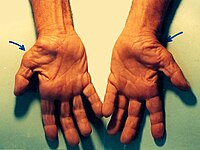
Photo from wikipedia
PURPOSE The study aimed to identify the variables that differentiate judo athletes at national and regional levels. Multivariable analysis was applied to biomechanical, anthropometric, and Special Judo Fitness Test (SJFT)… Click to show full abstract
PURPOSE The study aimed to identify the variables that differentiate judo athletes at national and regional levels. Multivariable analysis was applied to biomechanical, anthropometric, and Special Judo Fitness Test (SJFT) data. METHOD Forty-two male judo athletes from 2 competitive groups (14 national and 28 state levels) performed the following measurements and tests: (1) skinfold thickness, (2) circumference, (3) bone width, (4) longitudinal length, (5) stabilometric tests, (6) dynamometric tests, and (7) SJFT. The variables with significant differences in the Wilcoxon rank-sum test were used in stepwise logistic regression to select those that better separate the groups. The authors considered models with a maximum of 3 variables to avoid overfitting. They used 7-fold cross validation to calculate optimism-corrected measures of model performance. RESULTS The 3 variables that best differentiated the groups were the epicondylar humerus width, the total number of throws on the SJFT, and the stabilometric mean velocity of the center of pressure in the mediolateral direction. The area under the receiver-operating-characteristic curve for the model (based on 7-fold cross validation) was 0.95. CONCLUSION This study suggests that a reduced set of anthropometric, biomechanical, and SJFT variables can differentiate judo athlete's levels.
Journal Title: International journal of sports physiology and performance
Year Published: 2022
Link to full text (if available)
Share on Social Media: Sign Up to like & get
recommendations!